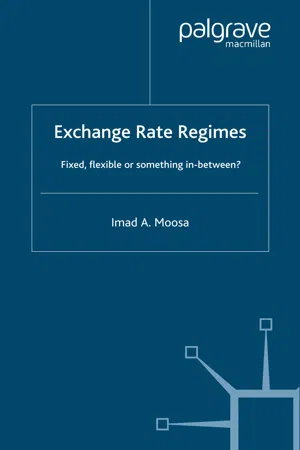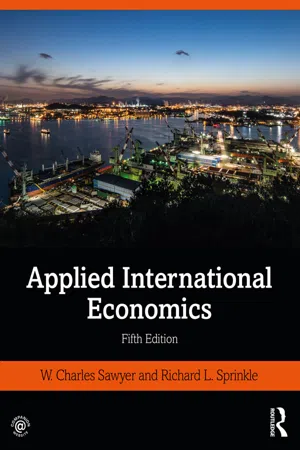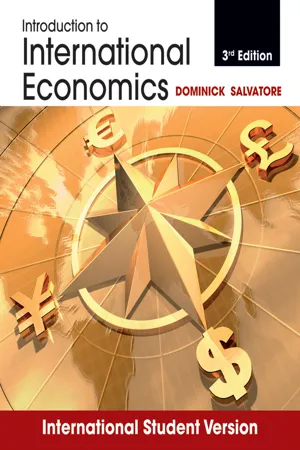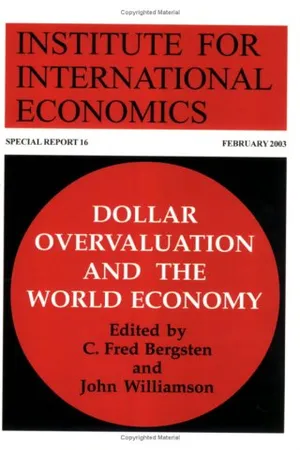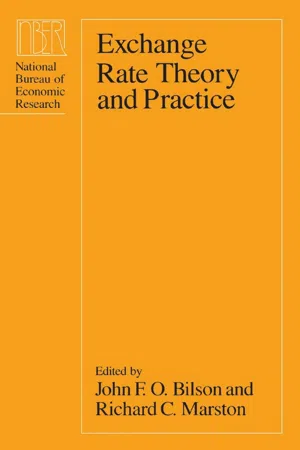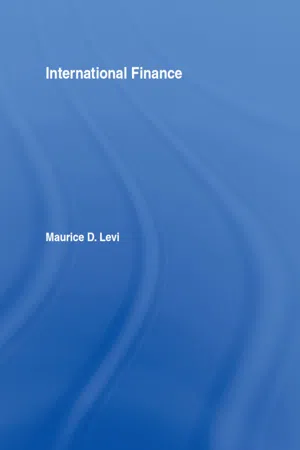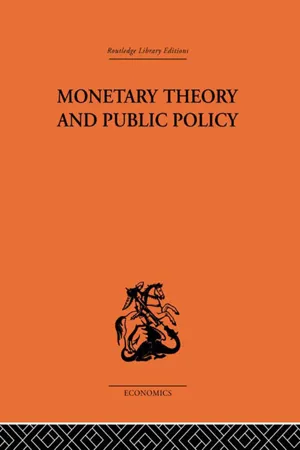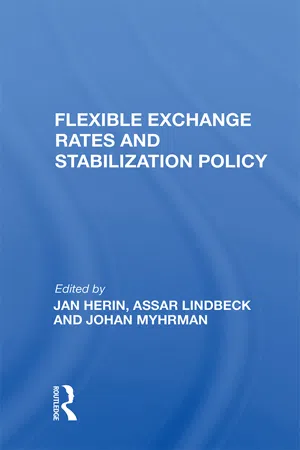Economics
The Equilibrium Exchange Rate
The equilibrium exchange rate is the theoretical value at which the supply and demand for a currency are balanced, resulting in a stable exchange rate. It is influenced by various factors such as inflation, interest rates, and economic growth. When a currency's exchange rate deviates from its equilibrium level, it can lead to trade imbalances and economic instability.
Written by Perlego with AI-assistance
Related key terms
1 of 5
11 Key excerpts on "The Equilibrium Exchange Rate"
- eBook - PDF
Exchange Rate Regimes
Fixed, Flexible or Something in Between?
- I. Moosa(Author)
- 2006(Publication Date)
- Palgrave Macmillan(Publisher)
The second problem is that the equilibrium values of the exchange rate are ranked differently by the two countries involved in the bilateral exchange rates. For example, one country may prefer E 1 while the other prefers E 3 . A situation like this could lead to conflict in the economic policies of the two countries. The third problem is that speculation as well as balance of payments disturbances may cause sharp fluctuations in the exchange rate, which lead to an unnecessary and wasteful reallocation of resources. For E 3 E 2 E 1 Q E S D Figure 2.11 Multiple equilibria in the foreign exchange market The Role of the Exchange Rate in the Economy 43 example, if the exchange rate rises slightly above E 1 , speculators will start buying the foreign currency, thinking that it will rise further. The exchange rate will rise beyond the unstable level E 2 , all the way to the stable level E 3 . When it reaches E 3 , speculators sell the foreign currency, causing the exchange rate to fall all the way to E 1 . The effect of a balance of payments disturbance is illustrated in Figure 2.12. A fall in the demand for foreign exchange is represented by a shift in the demand curve, and The Equilibrium Exchange Rate falls from E 1 to E 2 . This big drop is caused by the backward-bending nature of the supply curve. Changes in the exchange rate would be less dramatic under a normal upward-sloping supply curve. The effect of the exchange rate on the current account of the balance of payments emanates from the effect of changes in the exchange rate on prices and, therefore, the demand for domestic and foreign goods (exports and imports). When the exchange rate rises (the domestic currency depreciates), prices of exports in foreign currency terms fall while prices of imports in domestic currency terms rise. - eBook - PDF
- Peter J. Montiel(Author)
- 2011(Publication Date)
- Cambridge University Press(Publisher)
3 If we adopt the depen-dent-economy framework, for example, we can define the real exchange rate as follows: Q = P T / P N = SP ∗ T / P N Under the floating exchange rate regime, the nominal exchange rate S is endogenous. But even under fixed rates, P N is an endogenous variable. In either case, then, Q is 3 We have already seen this to be so in the Mundell-Fleming fixed-exchange rate model of Part 2, in which the real exchange rate was endogenous both in the short run and in the medium term. 374 Exchange Rate Management endogenous, and as such, it must be determined as the outcome of the economy’s macroeconomic equilibrium. This observation has caused some economists to question the very notion of distinguishing between the actual real exchange rate and its notional equilibrium value, but this view, which was the first objection to defining and measuring the equilibrium real exchange rate mentioned in the introduction to this chapter, is fundamentally misguided. The distinction between the actual real exchange rate and its equilibrium value is not one between disequilibrium and equilibrium but rather between different types of equilibria (i.e., equilibria conditioned on different values of macroeconomic variables). 1. Defining Equilibrium The traditional definition of the equilibrium real exchange rate is that it is the value of the real exchange rate that is simultaneously consistent with internal and external balance, conditioned on sustainable values of exogenous and policy variables. 4 The term internal balance in this definition refers to a situation in which the markets for domestic goods and labor are both in equilibrium. Thus it corresponds to what we referred to in Chapter 7 as a short-run macroeconomic equilibrium with full employment. External balance, on the other hand, refers to a situation in which the economy’s current account deficit is equal to the value of the sustainable capital inflows that it can expect to receive. - eBook - ePub
- W. Charles Sawyer, Richard L. Sprinkle(Authors)
- 2020(Publication Date)
- Routledge(Publisher)
In our example, the demand for and supply of pounds are shown in Figure 14.6. In this case, The Equilibrium Exchange Rate occurs when the quantity of pounds demanded is equal to the quantity of pounds supplied. In our example, this equilibrium is shown in Figure 14.6 at $2 per pound, point E. At this exchange rate, the amount of pounds that U.S. consumers want to purchase exactly matches the number of pounds that Britons are willing to supply in order to obtain dollars. For many individuals, the term exactly may be troubling, because exchange rates fluctuate over the course of a trading day and considerably more than that over longer periods of time. The precise equilibrium shown in Figure 14.6 should be thought of as an equilibrium that the foreign exchange market would achieve if everything else remained constant. However, exchange rates move very quickly as economic conditions and expectations change. There are already several variables we have described that can influence exchange rates, and these variables are continually changing and thus The Equilibrium Exchange Rate is constantly changing. 7 FIGURE 14.6 The Equilibrium Exchange Rate CHANGES IN The Equilibrium Exchange Rate To illustrate the effect of changes in income and relative prices on The Equilibrium Exchange Rate, we will describe several examples. First example, consider the case where the equilibrium in the foreign exchange market is $2 per pound, which is illustrated at point E in Figure 14.7. Now, assume that U.S. incomes increase, causing the demand for imports in the U.S. and the demand for British pounds to increase. The increase in the demand for pounds is illustrated as a shift in the demand curve to D 1. With the supply of pounds held constant, The Equilibrium Exchange Rate has increased from $2 dollars per pound to $3 dollars per pound. This new equilibrium is shown as point F in the Figure 14.7 - eBook - PDF
- Dominick Salvatore(Author)
- 2014(Publication Date)
- Wiley(Publisher)
276 Part Four The Balance of Payments, Foreign Exchange Markets, and Exchange Rates 0 50 100 0.50 1.00 1.50 2.00 150 200 250 300 350 E' C G B A F H R = $/ S' D Million /day FIGURE 11.1. The Exchange Rate with Flexible Exchange Rates. The vertical axis measures the dollar price of the euro (R = $/¤), and the horizontal axis measures the quantity of euros. With flexible exchange rates, The Equilibrium Exchange Rate is R = 1, at which the quantity demanded and the quantity supplied are equal at ¤200 million per day. This is given by the intersection at point E of the U.S. demand and supply curves for euros. At a higher exchange rate, a surplus of euros would result that would tend to lower the exchange rate toward the equilibrium rate. At an exchange rate lower than R = 1, a shortage of euros would result that would drive the exchange rate up toward the equilibrium level. If the U.S. demand curve for euros shifted up (e.g., as a result of increased U.S. tastes for EMU goods) and intersected the U.S. supply curve for euros at point G (see Figure 11.1), The Equilibrium Exchange Rate would be R = 1.50, and the equilibrium quantity of euros would be ¤300 million per day. The Depreciation An increase in the domestic currency price of the foreign currency. dollar is then said to have depreciated, since it now requires $1.50 (instead of the previous $1) to purchase one euro. Depreciation thus refers to an increase in the domestic price of the foreign currency. On the other hand, if the U.S. demand curve for euros shifted down so as to intersect the U.S. supply curve for euros at point H (see Figure 11.1), The Equilibrium Exchange Rate would fall to R = 0.5 and the dollar would be said to have appreciated (because fewer dollars are now required to purchase one euro). Appreciation thus refers to a decline in the domestic price of the foreign currency. - No longer available |Learn more
- C. Fred Bergsten, John Williamson, C. Fred Bergsten, John Williamson(Authors)
- 2003(Publication Date)
35 2 The Dollar’s Equilibrium Exchange Rate: A Market View MICHAEL R. ROSENBERG In theory, a currency’s value should gravitate over time toward its real long-run equilibrium value. If we were able to estimate this value, invest-ors would be able to identify the likely path that an exchange rate will take on a long-term basis and position their portfolios accordingly. Unfor-tunately, there is no uniform agreement among economists either on what exchange rate level represents a currency’s true long-run equilibrium value or on the method that should be used to estimate its value. For instance, the method with the widest following among economists and strategists—the purchasing power parity (PPP) approach, which equates a currency’s fair value with the trend in relative price levels—is also widely recognized to have serious limitations because other fundamental forces have often played an important role in driving the long-term path of exchange rates. The purpose of this paper is to describe how equilibrium exchange rate modeling can be useful for foreign exchange market participants. One of my principal goals is to demonstrate that equilibrium exchange rate modeling is not purely an arcane academic exercise. I begin by discussing the fundamental equilibrium exchange rate framework pioneered by John Williamson. I then survey several modeling attempts that use the FEER framework as well as others undertaken in recent years to estimate where the dollar’s equilibrium value versus the euro lies. Michael R. Rosenberg is managing director and head of global foreign exchange research at Deutsche Bank. Prior to joining Deutsche Bank in May 1999, he was managing director and head of international fixed income research at Merrill Lynch for 15 years. 36 DOLLAR OVERVALUATION AND THE WORLD ECONOMY Most model-based estimates suggest that the dollar is significantly over-valued versus the euro. I suggest that those estimates might be understat-ing the dollar’s true equilibrium value. - Eckhard Siggel(Author)
- 2016(Publication Date)
- Routledge(Publisher)
A situation of external deficit and massive unemployment shown in the diagram by the point A requires a combination of currency devaluation and greater fiscal ease rather than a single policy change, in order to achieve simultaneously external and internal balance. More generally, most situations of disequilibrium require more than one policy measure in order to achieve more than one policy goal. A combination of expenditure-changing (fiscal ease) and expenditure-switching (currency de-or revaluation) is needed to achieve internal and external balance. The Swan diagram also invites a discussion of the assignment problem, that is, which authority is responsible for which policy target, as well as the timing of policy interventions. Since the central bank deals with the exchange rate it naturally bears the responsibility for the external balance target, and the finance minister for internal balance. Exchange rate interventions have a much shorter, even immediate, implementation lag than fiscal policy changes. They may over-shoot the target, however, and need to be coordinated with changes in fiscal ease.Often governments try to avoid devaluation out of fear of increased inflationary pressure and political instability, and then resort to alternative policies, such as import restrictions. In the short run, such policies can help to achieve external balance, but they come at a cost of efficiency losses due to the introduction or increase of price distortions, as we have seen in the previous chapter.6.4 The Real Exchange Rate as a Tool of Analysis
The real exchange rate is an important tool for the analysis of currency misalignment. It has been defined in various ways by different authors. The first, and perhaps most common, definition is that of the nominal rate adjusted for price levels:(6.1) RER = E Pf /Pdwhere E is the nominal rate (i.e. the domestic price of foreign currency), and Pd and Pf are the domestic and foreign price indices, respectively. This definition of the real exchange rate implies that it appreciates4 if domestic prices rise faster than international prices, while the nominal rate remains constant. Alternatively, real appreciation also occurs when the nominal rate declines, relative to the price ratio Pf /Pd . Dornbusch uses the inverse definition (cf. Dornbusch and Kuenzler, 1993), which is also used by the IMF in exchange rate indices:(6.2) RER* = Pd /(E Pf )This inverse of RER has the advantage over the former that it expresses the value of the domestic currency in terms of foreign currency. Therefore, an increase means appreciation and a decrease means depreciation.- eBook - PDF
- John F. Bilson, Richard C. Marston, John F. Bilson, Richard C. Marston(Authors)
- 2007(Publication Date)
- University of Chicago Press(Publisher)
The model of exchange rate determination developed in this paper also incorporates a theory of the determination of the real exchange rate by means of a general equilibrium specification of the condition of balance of payments equilibrium. This specification is consistent with the standard two- country, two-commodity model of the real theory of international trade, with the dependent economy model in which the home country produces and consumes its own nontraded good as well as a traded good that is a perfect substitute for goods produced and consumed in the rest of the world, and with the usual “Keynesian” model in which the home country produces an output that is distinct from the output of the rest of the world. An important feature of this model of balance of payments equilibrium is that both the level and the expected rate of change of the real exchange rate affect the desired difference between domestic spending and domestic income and the current account balance. Under the assumption of rational expectations, it follows that (the logarithm of) the real exchange rate that is consistent with balance of payments equilibrium (but not necessarily with a zero cur- rent account balance) depends on the long-run equilibrium real exchange rate and on the divergence between the actual level of net foreign assets held by domestic residents and the long-run desired level of such asset hold- ings. The dependence of the real exchange rate on the level of net foreign assets is consistent with the relationship described in a number of recent models of the dynamic interaction between the current account and the exchange rate. - Available until 4 Dec |Learn more
International Finance
Contemporary Issues
- Maurice D. Levi, Dilip Das(Authors)
- 2007(Publication Date)
- Routledge(Publisher)
AEA Readings in International Economics, Richard D. Irwin, Homewood, IL, 1968.Haberler, Gottfried, ‘‘The Market for Foreign Exchange and the Stability of the Balance of Payments: A Theoretical Analysis,’’ Kyklos, Fasc. 3, 1949, pp. 193–218. Reprinted in Richard N. Cooper (ed.), International Finance, Penguin, Baltimore, 1969.Heller, H. Robert, International Monetary Economics, Prentice-Hall, Englewood Cliffs, NJ, 1974, Chapter 6.McKinnon, Ronald I., ‘‘Money in International Exchange: The Convertible Currency System,’’ Oxford University Press, 1979.Mundell, Robert A., International Economics, Macmillan, New York, 1968, Chapter 1.Pippenger, John E., Fundamentals of International Finance, Prentice-Hall, Englewood Cliffs, NJ, 1984, Chapter 5.APPENDIX A
Stability in foreign exchange markets
Let us consider the stability of S($/£), assuming for simplicity that the only two countries in the world are the United States and the United Kingdom, and that there are no capital flows. Under these assumptions, the quantity of pounds demanded is equal to the value of British exports. We can write this as px · Qx (S · px) where px is the pound price of British exports and Qx (S · px ) is the quantity of British exports. That is, the value of pounds demanded is the price of exports multiplied by the quantity of exports. [We put (S · px ) in the parentheses to signify that Qx depends on (S · px ), which is the dollar price of British exports; S is short for the spot rate, S($/£). It is the dollar price that is relevant to the US buyer of British exports.]The quantity of pounds supplied is equal to the value of British imports. We can write this as (pm /S) · Qm (pm /S) where pm is the USdollar price of British imports and Qm (pm /S) is the quantity of British imports. That is, the value of pounds supplied is the pound price of imports (pm /S) multiplied by the quantity of British imports, where the term in parentheses in Qm (pm /S) signifies that the quantity of imports depends on pm /S [Recall that since S is the exchange rate S($/£), dividing by S puts the dollar price of imports into British pounds. It is the pound price of British imports, pm /S - eBook - ePub
- Rebecca Driver, Peter J N Sinclair, Christoph Thoenissen(Authors)
- 2013(Publication Date)
- Taylor & Francis(Publisher)
completely captures the impact of the relevant fundamentals and the transition path generated by past shocks, this can only be an indication. In addition it assumes that any risk premium (see below) is defined as being dependent on fundamentals, rather than simply the unexplained part of any empirical estimate.8 The question of whether any misalignment of the exchange rate is appropriate or not therefore needs to be considered in the more general context of whether the monetary policy response itself is appropriate or optimal.9 The same is true for the difference between medium- and long-term values of fundamentals.10 In practice, in the short term at least, real and nominal exchange rates tend to move very close together.11 This point is often confused in discussion of the equilibrium value of particular exchange rates. For example, in choosing a particular bilateral exchange rate which sterling might lock into vis-a-vis the euro upon entering EMU, it is too simplistic to argue, as is often done, that a particular nominal exchange rate is economically unsustainable. In principle, any initial value of the nominal exchange rate is sustainable so long as relative inflation rates can adjust so as to bring about a movement in the real exchange rate to its warranted equilibrium. Of course, that is not to deny that if the initially chosen rate is misaligned in real terms, this transition may be potentially costly in terms of lost output.12 In general effective exchange rate indices are calculated as a geometric rather than an arithmetic mean. This has the useful property that any calculation of percentage change will be independent of the base year chosen.13 The sum ofijwill be unity by construction. If the real exchange rate of interest is a bilateral exchange rate there will only be one j .14 See Pagan (2003) for an excellent discussion of the strengths and weaknesses of different approaches along this spectrum in the context of forecasting inflation.15 One caveat is that it is assumed that macroeconomic fundamentals are the key driving variables underlying movements in the exchange rate. In practice, particularly in the short term, this may not be true. Andersen et al . (2003) and Faust et al - eBook - ePub
- Kenneth K. Kurihara(Author)
- 2013(Publication Date)
- Taylor & Francis(Publisher)
PART IIIDomestic vs International EquilibriumPassage contains an image 17
The External Value of Money—The Gold StandardINTERNATIONAL as well as domestic economic stability presupposes stability in the value of money as a sine qua non, among other requirements. The external value of money or the domestic price of foreign currencies on the foreign exchange market is determined diversely under different monetary standards, and the way in which it is determined affects domestic and international economic welfare differently. It is therefore necessary to examine both the theoretical basis and the practical implications of various international currency systems. We shall consider three typical monetary standards, namely, (a) the gold standard, (b) the paper standard, and (c) the mixed standard—the International Monetary Fund. Our discussions in this chapter and the two following may serve as a background for an understanding of the more complex problems of international and domestic equilibrium presented in the last two chapters. We shall begin with the gold standard.Stable Exchange RatesIt seems useful to begin with a definition of the gold standard. A country is said to be on the gold standard (a) when its monetary authority is committed to a policy of buying and selling gold at a fixed price in unlimited amounts, (b) when the purchasing power of a unit of its currency is kept equal to the purchasing power of a given weight of gold, and (c) when the external value of its currency is fixed through the medium of gold. Practically all major trading nations were on gold in the above sense before 1931, and gold served as a principal international means of payment and as an important reserve of international liquidity.Under an international gold standard exchange rates are fixed, since each national currency is convertible into gold at a fixed rate and therefore into another currency at a fixed rate. If, for example, $4 and £1 can both be exchanged for the same amount of gold, it follows that the exchange value of £ 1 cannot be above or below $4. In reality exchange rates under the gold standard do fluctuate but only within the narrow limits set by the gold export and import points, that is, by the cost of sending gold from one point of the system to another. The gold export point is the upper limit beyond which the domestic price of a foreign currency may not rise, while the gold import point - eBook - PDF
- Jan Herin(Author)
- 2019(Publication Date)
- Routledge(Publisher)
Under flexible ex-change rates instantaneous portfolio equilibrium is obtained through changes in the valuation of assets-that is, through changes in the exchange rate. Exchange rate in the short run and in the long run 169 Whereas a desire to hold. a larger proportion of foreign assets results in an immediate adjustment of private portfolios and has no long-run consequences under fixed exchange rates, such a shift under flexible exchange rates will give rise to a gradual adjustment process and will have long-run consequences. The exchange rate will depreciate initially and the current account will move to a surplus. This surplus increases the actual stock of foreign assets. In general, the exchange rate in the new equilibrium position will not be the same as before the portfolio shift because the long-run stock of wealth will be different. (iii) The dynamic behavior of the exchange rate and of the balance of pay-ments depends critically on the nature of expectations formation. Traditional theory has neglected the relevant problem of instability under flexible ex-change rates, i.e. the problem of instability of relative asset prices, by focusing on balance of payments flows. The crude purchasing power parity theory of exchange rates has also bypassed the problem of possible instability by ignor-ing the fact that different monies, and assets denominated in different curren-cies, are substitutes. The requirement of no expected profits does not rule out dynamic instability. 1 In fact, in the case of perfect foresight the exchange rate is indeterminate-for any initial exchange rate, there is a path along which all markets clear and expectations are continuously fulfilled. Only one of these paths converges to the stationary state. Since hyperdeflation, or inflation seldom, if ever, develops by force of speculative behavior alone, there must be reasons why the deviant paths cannot be sustained.
Index pages curate the most relevant extracts from our library of academic textbooks. They’ve been created using an in-house natural language model (NLM), each adding context and meaning to key research topics.
